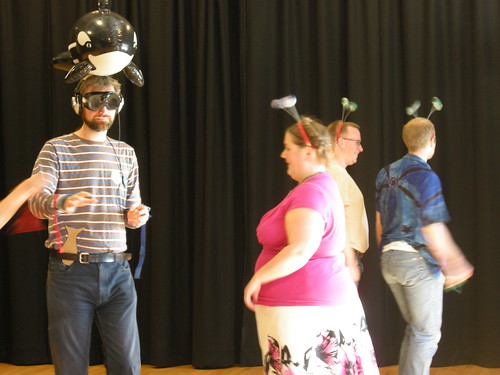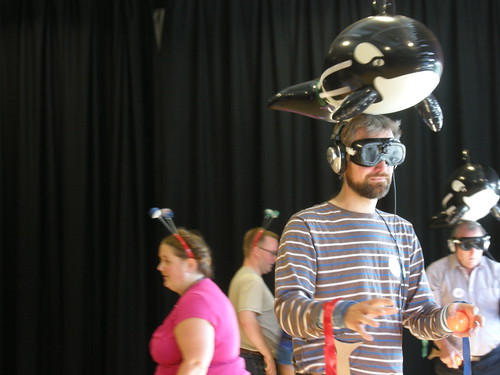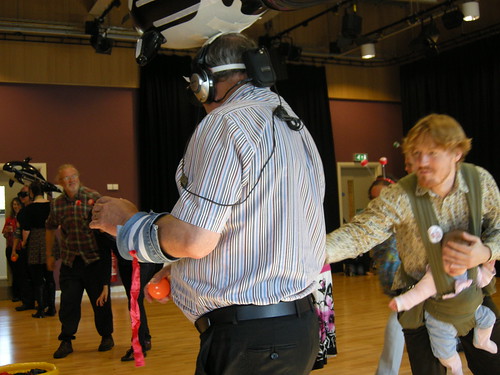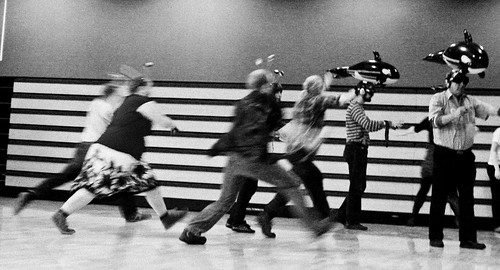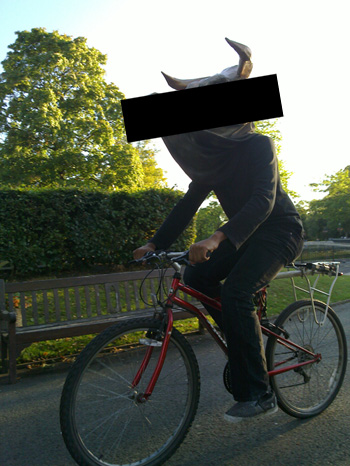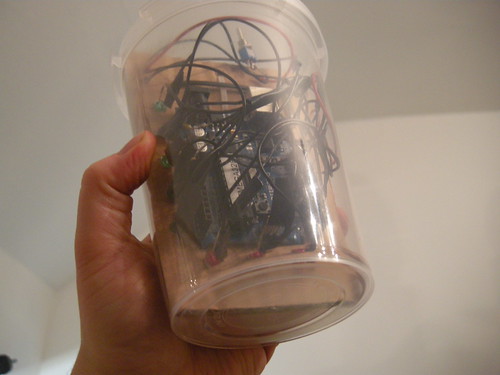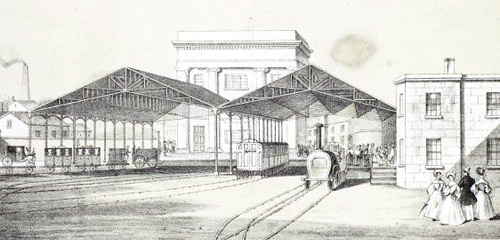Since doing an exchange visit there in 2005, my contact with Joshibi University of Art and Design and its students has included: helping to host their exchange students coming to Birmingham; effectively working there as a technician for a month; countless days just sort of hanging out there; keeping in contact with several pupils and alumni, including visiting their homes and having them stay with me in the UK; and hearing from alumni friends their tales of working as artists post-graduation and their encounters with graduates from other universities. As a result, I have a pretty well-formed idea of some of the things I would like to do to shake things up a bit, beyond my low-level “So, have you ever considered showing your work, outside of a gallery context” vibrations.
In 2006, 2007 and 2008 I also coordinated and delivered the social programme as part of the annual Joshibi Summer School. This involved sorting out all the pastoral and evening/weekend social stuff for the 30-or-so students who would spend a month based at Bournville Centre for the Visual Arts (BCVA).
We’ve had many conversations about how the Summer School programme could be improved. The main problems from my point of view are that the students arrive as a group; take over a block in a halls of residence as a group; are the only group studying at Bournville over the summer; have an interpreter with them the whole time; and have negligible contact with anyone outside of the staff and the other Summer School students. They may get to experience something of a different way of approaching art education, but there’s a lot missing in terms of cultural exchange and development of language skills.
I decided I didn’t want to work on the social programme this year, but was later invited to provide a day’s teaching for the Summer School. Based on last year’s werewolf success, and my recent work with BARG, there was no doubt that a game would be involved.

My contribution was to form a starting point for a larger project where the students would go on to develop work that contrasts London and Tokyo. I ran two workshops in the morning where we compared the places in Japan they recommended I visited to the places that actually had meaning to them in their day-to-day lives. This got us from guidebook staples such as the Emperor’s Palace and Kiyomizu-dera to stories of favourite ice-cream shops, overheard sounds of children playing in campsites and stars as seen above car parks.
We also looked at the landmarks that we give significance to in our journeys through landscapes that we are very familiar with. Taking our journeys to university as an example, we drew maps and uncovered more stories. I’m familiar enough with the bus ride to the Joshibi Sagamihara campus that I could recount my personal map of that journey and compare it to theirs. This experience lasting only a few seconds is so completely and vividly on my map that I’m genuinely shocked to realise now that it’s a memory from 4 years ago.
As expected, the smell of the chicken farms featured prominently in the cycled versions of the journey…

For the afternoon, I’d prepared a scavenger hunt around Bournville Green and the surrounding area.
This was designed as a team game, but with significant components where each student would be very much working alone (…unless they plucked up the courage to ask passers by for assistance!). Use of the Japanese language was, of course, banned throughout.

The students randomly selected a question to tackle and then had some time to discuss it with their team mates. The questions were worded to avoid typical Japanese constructions of English. I also tried to avoid making them so simple that no discussion was needed to fully understand them.
Examples include.
- There is a car park at the Western edge of the park. Around it, with one end in the ground, are wooden “dragon’s teeth”. How many dragon’s teeth are there?
-
Stand between the Porter’s Lodge and the church. Look at the church. Can you see the carved wooden panel? How many flowers does it have? What is the man holding in his left hand?
- Go to the chemists and find a lilac-coloured dog hanging up by a door. What colour is his collar, and how many diamonds are on the front of it?
- In the alleyway between the chemists and Louise’s, there are some old style posters. What is the name of a UK city written on one of them?
- Go to the butchers shop. What is the name of the sheep on the counter near the window?
- Go to the Wyevale garden centre. There is a scarecrow near one of the doors. How much did his hat cost?
There were a range of strategies employed in designing the questions. Some of them, such as the sheep’s name question above, could only be answered if the student asked the appropriate question of the relevant shop keeper. Others would be made infinitely easier if they asked a member of the public for help in explaining what a particular word refers to (e.g. dragon’s teeth).
The other major aim was to get the students out and into parts of Bournville that they would never normally go to. This had the intended bonus of meaning that I had to seek out these places first. I was a student at BCVA for 5 years, and yet there were so many places in that tiny area that I had never been to until the planning stages of this game. I had lots of adventures and conversations: so much of Bournville is hidden away in a secret second-layer-back, and there are some truly class acts working there.
I was also determined that I would work with what was already in situ, and not parachute in any foreign bodies to plant for the game. The sharks, Iggle Piggles and Bill Oddies were all there already, waiting to be discovered and played with.
Right, so we had the basic mechanism of having to go to places and find answers to questions. The other aspect of the game design was about how to make this an intense, sometimes visceral experience.

Prior to explaining the game rules, we’d confiscated (in a nice way!) all their mobile phones, electronic dictionaries and phrasebooks. This was originally done to ensure that looking things up didn’t replace discussion, but I think it also had quite a wrenching effect, because this technology is usually very heavily relied upon.

I deliberately made it so that, after the initial discussion phase, each player then had to go off independently to find the answer. This took away another safety net of group decision making.
The other thing to do was to add a magic vest in the form of some hats for the players to wear whist they were out and about.

This covered my usual criterion for having an element of silliness involved in order to break down a few barriers, but as Holly Gramazio pointed out at Hide and Speak, your players look like criminals and, if the students were going to be in the bank counting CCTV cameras, I wanted it to be clear that they probably weren’t dangerous! The “help me find stuff” labels on the hats were intended as an invitation for people not involved in the game to approach the students and initiate conversations.
The weather was drizzly, the students were extremely tired after spending a long weekend in London (not to mention the jet lag!), energy levels were low, and I had to tweak some stuff on the fly to increase the pacing, but it all worked! It worked a treat!


It was great to see the balloons bobbing around on the green and in front of the parade of shops. It was fun to see the teams playing jan-ken-pon to decide the next runner, but substituting diddle-diddle-dum lyrics so as to avoid the 50 point fine for speaking Japanese. It was satisfying to hear small groups of students with nothing to do standing around and chatting in English. It was worrying to hear that one girl hadn’t been seen for 25 minutes, but heart-warming to hear from the search party that she’d been found in the park with a gang of kids around her trying to help her solve her clue. We giggled to hear the story of people offering to help count dragon’s teeth. It did nothing less than warm my cockles to hear someone describe the hats as being magic, a comfort, and to thank me for making them wear them.



All three teams did really well and the rain mostly stayed away until we had finished playing. The final scores were in the region of 120 points (average 10 points per question) with only maybe 4 failed questions per team.
I finished off the day with a more formal presentation about the use of mechanisms and rule sets to instigate interactions with spaces; how presenting something as a game contrasts with presenting it as a piece of performance artwork; the importance of stories; the importance of magic vests/hats; the importance of silliness (and how it’s easier to be part of a large group doing silly things rather than being by yourself doing silly things) and how doing projects in public spaces confers ownership of that space to you (in the sense of responsibility and empathy, rather than of power).
Anyway, it looks like I may yet end up doing some social stuff with the group on Saturday: I may take the opportunity to quiz them on how the game has affected their perception of Bournville…

